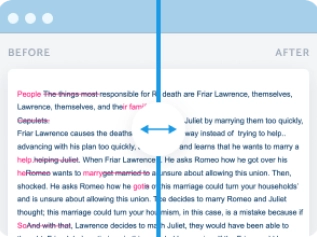Research Design Example: How to Choose the Right Type for Your Study
Table of contents
- 1 What Is Research Design?
- 2 Types of Research Design (With Real Examples)
- 3 How to Choose the Right Study Framework for Your Exploration?
- 4 Research Design Example – Step-by-Step Walkthrough
- 5 How to Write a Research Design (Template & Tips)
- 6 Key Takeaways & Final Thoughts
- 7 FAQ: Answers to Common Research Design Questions
A good research design is important for any study. It helps experts collect data, analyze results, and draw meaningful conclusions. Choosing the right study framework depends on the research questions, data type, and study goals. This guide explains different types of research designs with real-life examples. You will learn how to select the best approach for your exploration. We will also look at a step-by-step research design example. Whether you are using a qualitative or quantitative approach, this guide will help you create a strong plan for your exploration.
What Is Research Design?
This is the blueprint for any academic work. It outlines how the study will be conducted and includes data collection methods, analysis techniques, and sampling strategies. A strong study design ensures reliable and valid results and helps researchers draw meaningful conclusions.
A good framework is essential for any academic project. It provides structure, guides the research process, and ensures that the work answers its research questions. Without a clear research design, it is difficult to collect data effectively and analyze it properly. Researchers use different research designs depending on their objectives and the type of data they need.
Characteristics Common to Different Types of Research Design
- Neutrality: The analyst must stay objective and avoid bias.
- Reliability: The study should produce consistent results when repeated. Random errors should be minimized to ensure accuracy.
- Validity: The exploration must be based on proper methods to avoid systematic mistakes.
- Generalizability: Findings should apply to a larger population, not just a small sample.
- Flexibility: The exploration should allow adjustments based on new data or unexpected outcomes.
Why Does It Matter for Your Exploration?
A well-structured study framework helps achieve research objectives. It ensures data accuracy and minimizes bias. It provides a clear roadmap for the exploration process, making it easier to test hypotheses and analyze data effectively.
Now that you know the answer to “What is research design?”, it’s crucial to understand its significance in the writing process. Choosing the appropriate study design is important because it affects the validity of the work. A strong design helps scholars collect reliable data, control variables, and reduce errors. For example, in an experimental study design, researchers must carefully control the independent variable to learn its effect on the dependent variable. If the design is weak, the results may not be valid or meaningful.
Key Elements of a Strong Research Design
- Research Questions — Define the purpose of the work. A clear research question helps focus the exploration.
Example: “Does a new teaching method improve student performance?”
- Sampling Method — Choose participants or data sources. The method should match the approach you use.
Example: Randomly assign students to an experimental study.
- Data Collection Methods — Decide how to gather data. Surveys, interviews, and experiments are common methods.
Example: Using focus groups to collect qualitative data.
- Variables — Identify independent and dependent variables.
Example: Analyzing how sleep (independent variable) affects test scores (dependent variable).
- Ethical Considerations — Ensure ethical guidelines are followed. Researchers must get informed consent and protect participants’ privacy.
- Data Analysis Plan — Select statistical or thematic analysis methods.
Example: Using statistical tests to describe quantitative data.
Types of Research Design (With Real Examples)
Study design is divided into qualitative and quantitative approaches, each with different methods and goals. Qualitative research explores ideas and experiences using non-numerical data, while the quantitative approach relies on numbers and statistics to test hypotheses and find patterns. Let’s compare these two methodologies.
Qualitative vs. Quantitative Research Design
|
Feature |
Qualitative Approach |
Quantitative Approach |
|
Definition |
Focuses on non-numerical data to understand concepts, opinions, or experiences. |
Uses numbers and statistics to test hypotheses and measure outcomes. |
|
Purpose |
Explores ideas, behaviors, and social patterns. Seeks to understand “why” and “how.” |
Measures and analyzes variables to find patterns, relationships, or cause-and-effect. |
|
Data Type |
Descriptive, non-numerical data like words, images, or observations. |
Numerical data is often collected in structured formats like surveys or experiments. |
|
Methods |
Interviews, focus groups, observations, case studies, and open-ended surveys. |
Experiments, surveys with closed-ended questions, statistical analysis, and structured observations. |
|
Strategy |
Subjective and interpretive. Experts analyze meanings and perspectives. |
Objective and measurable. Researchers aim for accuracy and reliability. |
|
Flexibility |
More flexible. The exploration process may change as new insights emerge. |
More structured. Follows a planned process with set rules and steps. |
|
Analysis |
Uses thematic analysis, coding, or narrative analysis to find patterns and meanings. |
Uses statistical methods like averages, correlations, and hypothesis testing. |
|
Example Study |
An exploration using interviews to understand teachers’ experiences with online learning. |
A study measuring the effect of a new drug on blood pressure in a controlled experiment. |
|
Outcome |
Provides deep understanding and detailed descriptions. |
Produces measurable results that can be compared and generalized. |
Overview of Key Research Design Types
Different examples of research designs help explorers answer specific questions based on their goals. Below are key types, their definitions, and real-life examples.
- Descriptive Research Design:
Definition: Describes characteristics of a group, event, or phenomenon without testing relationships or cause-and-effect. It focuses on what is happening rather than why it happens.
Example: A study analyzing students’ mental health through surveys. Researchers collect data on stress levels, sleep habits, and academic performance without influencing any factors.
- Experimental Research Design:
Definition: Tests cause-and-effect relationships in a controlled setting. Analysts manipulate one variable (independent variable) and observe changes in another (dependent variable).
Example: A project testing a new teaching method’s impact on student performance. Students are randomly assigned to two groups — one follows the new method, while the other follows the traditional method. Academics compare test scores to measure the effect.
- Correlational Research Design
Definition: Investigates relationships between two variables without manipulation. It shows patterns but does not establish cause and effect.
Example: A work exploring the link between social media use and academic performance. Researchers analyze student records and compare grades with reported social media usage.
- Explanatory Research Design
Definition: Explores reasons behind observed patterns and relationships. It helps experts understand why certain trends exist.
Example: An exploration of factors influencing teacher job satisfaction. Researchers analyze how workload, salary, and work environment impact motivation.
- Cross-Sectional Research Design
Definition: Examines data from a specific point in time. It provides a snapshot of trends but does not track changes over time.
Example: A survey measuring social media use among teenagers in 2024. Analysts collect data once and analyze usage patterns.
- Case Study Research Design
Definition: Provides an in-depth analysis of a single case or a small group. It allows researchers to explore complex issues in detail.
Example: A study on how one school implements a new teaching method. Researchers interview teachers, students, and parents and analyze qualitative data.
- Longitudinal Research Design
Definition: Tracks change over time by studying the same group repeatedly. It helps identify long-term trends.
Example: A study following the same group of students for five years to track learning outcomes. Experts collect data annually and observe changes.
- Action Research Design
Definition: A practical approach to solving real-world problems. It involves cycles of planning, acting, observing, and reflecting.
Example: A teacher testing a new classroom strategy and adjusting it based on student feedback. Experts analyze student responses to improve teaching techniques.
- Quasi-Experimental Research Design
Definition: Similar to an experimental design but lacks random assignment. Researchers study cause-and-effect in real-world settings.
Example: Comparing student performance in two schools using a new teaching method. Since students are not randomly assigned, experts use statistical analysis to minimize bias and draw conclusions.
How to Choose the Right Study Framework for Your Exploration?
Factors to Consider When Selecting a Research Design
Choosing the right examples of research design is key to getting valid and reliable results. Analysts should consider these factors before deciding:
- Researcher’s Expectations and Objectives: The design should fit the study’s goals. Personal experiences may require a qualitative approach. At the same time, numerical trends often need a quantitative method.
- Type of Data Needed: Use a quantitative design for numbers and statistics. Choose a qualitative design for opinions and behaviors. A mixed-methods approach works when both types of data are needed.
- Practical Constraints: Time, budget, and resources affect research choices. Some methods, like experiments, need more time and funding, while surveys or interviews may be more practical.
- Ethical Considerations: Researchers must protect participants’ rights, get informed consent, and ensure confidentiality. Extra care is needed for vulnerable groups.
Common Mistakes to Avoid
❌ Using an inappropriate study structure. The wrong method can lead to inaccurate conclusions. The chosen structure must fit the research question and data type.
❌ Failing to define research questions clearly. Without clear questions, the project may lack direction. It leads to weak or irrelevant findings.
❌ Poor sampling methods affecting data quality. Choosing the wrong participants can make results less reliable. A sample should be representative of the target population.
❌ Ignoring ethical considerations. Failing to get consent or protect privacy can harm participants and invalidate the exploration. Ethics should always be a priority.
Research Design Flowchart (Visual Guide for Selection)
Choosing the right study design depends on your goals, data type, and analysis method. This guide helps you decide whether qualitative or quantitative research is best for your work.
|
Question |
Qualitative Approach |
Quantitative Approach |
|
What is your main goal? |
To explore ideas, experiences, or meanings. |
To test hypotheses, measure variables, or find patterns. |
|
What type of data will you collect? |
Words, images, observations (non-numerical). |
Numbers, statistics, structured responses. |
|
How will you gather data? |
Interviews, focus groups, case studies. |
Surveys, experiments, numerical analysis. |
|
What is your methodology? |
Flexible, open-ended, and interpretive. |
Structured, measurable, and objective. |
|
How will you analyze the results? |
Thematic analysis, coding, narrative study. |
Statistical tests, averages, correlations. |
|
Example Study |
Understanding student experiences in online learning through interviews. |
Measuring the impact of a new teaching method on test scores. |
Research Design Example – Step-by-Step Walkthrough
Understanding how to use a study framework is important for planning a strong project. Below are three examples, including a research design example quantitative, that show step-by-step how quantitative, qualitative, and mixed-methods explorations are structured. These examples help explain the process clearly.

🟨 Example 1 — A Quantitative Experimental Research Design
An expert wants to test if a new math app improves student performance.
- Research Question: Does using the math app increase test scores?
- Hypothesis: Students using the app will score higher than those who don’t.
- Participants: Two groups of 50 students each (experimental and control groups).
- Method: One group uses the app, while the other follows regular lessons.
- Data Collection: Pre-test and post-test scores are recorded.
- Analysis: Statistical tests compare score improvements between the groups.
- Conclusion: If the experimental group improves more, the app is effective.
🟨 Example 2 — A Qualitative Case Study Research Design
A researcher explores how high school teachers adapt to online learning.
- Research Question: How do teachers adjust their teaching strategies for online classes?
- Participants: Five experienced high school teachers.
- Method: In-depth interviews and classroom observations.
- Data Collection: Notes, transcripts, and personal reflections from teachers.
- Analysis: Identifying common themes and patterns in their experiences.
- Conclusion: The study provides insights into challenges and best practices for online teaching.
🟨 Example 3 — A Mixed-Methods Research Design
An expert analyzes student motivation in online learning using both numbers and personal experiences.
- Research Question: What factors influence student motivation in online classes?
- Participants: 100 students for surveys and 10 students for interviews.
- Method: A survey measures motivation levels, while interviews explore personal experiences.
- Data Collection: Numerical survey responses and detailed interview transcripts.
- Analysis: Statistical methods analyze survey results, while thematic analysis examines interview responses.
- Conclusion: The exploration combines both data types to give a full picture of student motivation.
How to Write a Research Design (Template & Tips)
Writing a strong study framework helps analysts stay focused and ensures that results are meaningful. Below are the essential sections of a study structure, along with a sample template to guide the writing process.
Essential Sections of a Research Design
1. Title and Introduction.
The title should be clear and specific, reflecting the study’s main focus. The introduction provides background information and explains the importance of the project.
- Introduce the topic and why it matters.
- Give a brief overview of existing academic works related to the topic.
- Highlight gaps in previous studies and explain how this project will contribute new knowledge.
- Clearly state the purpose of the work.
✅ Example:
“The Impact of Online Learning on Student Engagement in High Schools.”
2. Research Questions and Objectives.
Research questions guide the study and help define what needs to be explored or measured. Objectives are specific goals that show what the study aims to achieve.
- Research Questions: Clear, focused, and answerable.
- Objectives: Measurable and aligned with the questions.
✅ Example:
Research Question:
“How does online learning affect student engagement in high schools?”
Objectives:
-
- To analyze student participation in virtual vs. in-person classrooms.
- To examine how online learning influences student motivation.
3. Research Design Type.
This section explains whether the study is qualitative, quantitative, or mixed-methods. It should justify why this approach is best for answering the study questions.
- Qualitative Approach: Focuses on understanding experiences and meanings (e.g., interviews, observations).
- Quantitative Approach: Focuses on numbers, measurements, and statistical analysis (e.g., experiments, surveys).
- Mixed-Methods Approach: Combines both methods for a broader perspective.
✅ Example:
“This study will use a mixed-methods approach, collecting both numerical data from surveys and detailed insights from student interviews.”
4. Participants and Sampling.
This section describes who will take part in the exploration and how they will be selected.
- Who: Describe the target population (students, teachers, employees, etc.).
- Sampling Method: Explain how participants will be chosen (random sampling, purposive sampling, etc.).
- Sample Size: Mention the number of participants and why it is appropriate.
✅ Example:
“The project will include 200 high school students selected through random sampling to ensure diverse perspectives.”
5. Data Collection Methods.
This section explains how information will be gathered. It should match the study framework type.
- Qualitative Methods: Interviews, focus groups, observations, and open-ended surveys.
- Quantitative Methods: Experiments, structured surveys, statistical records.
- Mixed-Methods: A combination of both (e.g., surveys + interviews).
✅ Example:
“Students will complete a survey with Likert-scale questions to measure engagement levels, followed by interviews with selected students for deeper insights.”
6. Data Analysis Plan.
Once data is collected, it needs to be analyzed properly to answer the research questions. This section explains how the data will be processed and interpreted.
- Qualitative Analysis: Thematic analysis, coding, pattern identification.
- Quantitative Analysis: Statistical tests (mean, correlation, t-tests, etc.).
- Software/Tools: Mention any tools used (SPSS, Excel, NVivo, etc.).
✅ Example:
“Survey data will be analyzed using statistical tests in SPSS, while interview responses will be coded to identify common themes.”
7. Ethical Considerations.
Every academic project must protect participants’ rights and follow ethical guidelines.
- Informed Consent: Ensure participants agree to take part voluntarily.
- Confidentiality: Keep data private and secure.
- Avoiding Harm: Minimize any risks to participants.
✅ Example:
“All participants will sign a consent form, and their identities will remain confidential. Data will only be used for study purposes.”
8. Limitations.
No study is perfect, and every study design has its limitations. This section acknowledges potential challenges and suggests ways to minimize them.
- Time constraints: Limited time may affect data collection.
- Sample bias: If participants are not diverse, results may not apply to a wider population.
- Data reliability: Self-reported data may not always be accurate.
✅ Example:
“A limitation of this exploration is that student engagement is self-reported, which may introduce some bias. To address this, multiple data sources will be used.”
Research Design Sample Template
This template helps organize your work clearly and structuredly. It ensures that all key sections, such as research questions, methods, and data analysis, are well-defined. Use this template to plan and document your study step by step.
📌 Title: (Enter the title of your work)
📌 Introduction: (Briefly describe the study, its purpose, and background)
📌 Research Questions:
- (Enter the main question)
- (Enter additional questions, if any)
📌 Objectives: (List specific goals of the study)
📌 Research Design Type: (Qualitative, Quantitative, or Mixed-Methods – explain why)
📌 Participants and Sampling:
- Who: (Describe participants)
- Selection Process: (Explain how participants are chosen)
- Sample Size: (Mention how many participants will be included)
📌 Data Collection Methods: (Describe how data will be gathered and why)
📌 Data Analysis Plan: (Explain how the data will be analyzed)
📌 Ethical Considerations: (Mention how confidentiality and consent will be handled)
📌 Limitations: (Identify potential challenges and how to address them)
Final Tips for Writing Strong Examples of Research Design
Creating a well-structured study framework is essential for producing reliable and meaningful results. Below are key tips to ensure clarity, accuracy, and ethical integrity in your work.
✔ Be Clear and Specific
Avoid vague or general descriptions. Clearly define each step of your research process so that others can understand and replicate it. Specify your study question, methods, data sources, and analysis techniques. If you are conducting interviews, mention how many participants you will include and how their responses will be analyzed. A detailed plan makes your work more organized and credible.
✔ Justify Your Choices
Every research decision should have a reason. Explain why you chose a particular study design type (qualitative, quantitative, or mixed-methods). Justify your sampling method by showing how it ensures fair and accurate representation. If you are using a survey, explain why it is the best tool for collecting your data. If you are analyzing data statistically, mention why a specific test is appropriate. Providing clear justifications makes your project stronger and more convincing.
✔ Follow Ethical Standards
Researchers have a key responsibility to protect participants. Ensure that all participants provide informed consent before participating in the project. Keep personal data confidential and store it securely. Avoid any form of harm, whether emotional, psychological, or physical. If your exploration involves sensitive topics, make sure to provide resources for participants who may need support. Ethical research builds trust and ensures valid, unbiased results.
✔ Plan for Limitations
No study is perfect, and every work has challenges. Identify possible limitations early and find ways to reduce their impact. If you are using self-reported data, acknowledge that responses may not always be accurate. If your sample size is small, mention that the findings may not apply to larger populations. Planning helps you address weaknesses before they affect your results. Acknowledging limitations also makes your exploration more transparent and trustworthy.

Key Takeaways & Final Thoughts
A good research design makes the process smooth and organized. It helps experts collect reliable data and reach valid conclusions. The right study plan depends on the research goal, data type, and any limitations. A clear plan saves time, avoids mistakes, and improves accuracy.
Using clear objectives, strong sampling methods, and ethical practices leads to great outcomes. Researchers should carefully choose their methods to match their study needs. Good planning helps avoid bias, ensures fairness, and makes results more trustworthy.
By using this guide, scholars can build a strong research design. This ensures reliable data, clear analysis, and useful conclusions. A well-structured research process helps collect data properly, analyze it correctly, and find valuable insights. Careful research leads to better understanding and meaningful discoveries.
FAQ: Answers to Common Research Design Questions
What Are the Main Types of Research Design?
The main types include descriptive, experimental, correlational, explanatory, cross-sectional, case study, longitudinal, action, and quasi-experimental design examples. Each type is used for different study objectives and data collection methods. Choosing the right one depends on the focus of an exploration and the type of data needed.
How Do You Choose the Best Research Design?
Selecting the appropriate study structure depends on several factors. Learners should consider their objectives, data collection methods, ethical constraints, and available resources. If the goal is to test hypotheses in a controlled environment, an experimental approach may be best. If the study aims to identify patterns between two or more variables, a correlational method might be suitable. Explorators must also think about practical constraints like time, budget, and participant availability.
What Are the Most Common Research Design Mistakes?
Some common mistakes are picking the wrong method, using unclear research questions, and using a bad sampling method. Ignoring ethics is another issue. Not randomly assigning people to an experiment can cause bias, and poor data collection can also make results unreliable. Therefore, students should plan their methods carefully to avoid these problems.







